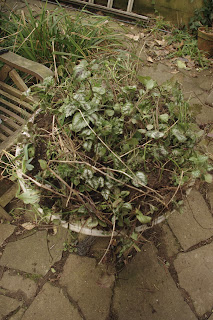The best things in life are free, for example taking advantage of plants natural tendency to propagate themselves. Tellima grandiflora self-seeded into the cracks between paving stones by my kitchen and I carefully extracted them to replant in the garden itself.
This White Comfrey (Symphytum orientale) self-seeded from others on the allotment and clumps particularly vigorously for some reason. I dug the clump up and divided the tangle of tap roots into eight separate specimens. I wasn't very gentle about it wrenching them apart and slicing with the spade where necessary.
Comfrey grows back strongly as long as you have a good piece of root. The biggest division I planted back where it came from and the rest were bound for the garden.
From time to time I work with an old friend who has developed a wonderful garden in the grounds of a music school in Hertfordshire. Several of the herbaceous borders are apt to be swamped by Yellow Archangel (Lamium galeobdolon subsp. montanum). In the process of weeding I made sure to get a bucketful to take away with me because I like it despite its bad reputation.
The terms "ground cover" and "invasive" are somewhat interchangeable and both can be applied to Yellow Archangel. Native to continental Europe and western Asia it is regarded as a rampant weed in some of the countries it has been introduced to.
Here in the UK it is an offence to plant in the wild under Schedule 9 of the Wildlife and Countryside Act, nonetheless is sold by garden centres and nurseries. Personally I think it has its uses as a ground cover in town and city but perhaps not a rural garden. Actually I have never seen it gone wild anywhere in the countryside though it is said to be invading native habitats.
NB Yellow Archangel is also the common name of the native plant found in ancient British woodlands which is the straight species Lamium galeobdolon. The two lipped tubular yellow flowers are very similar but the leaves do not have the frosted variegation of the subspecies montanum.

































